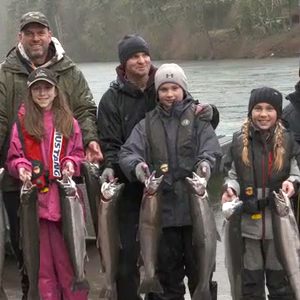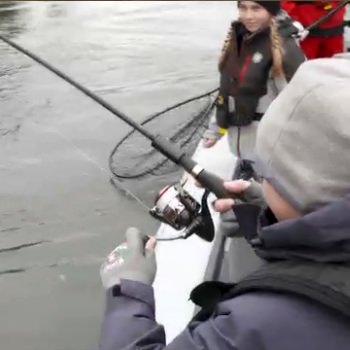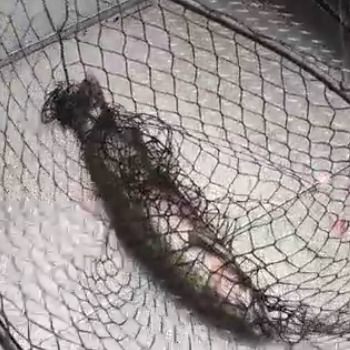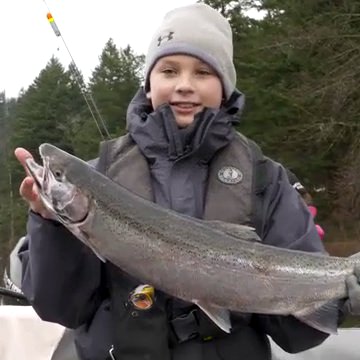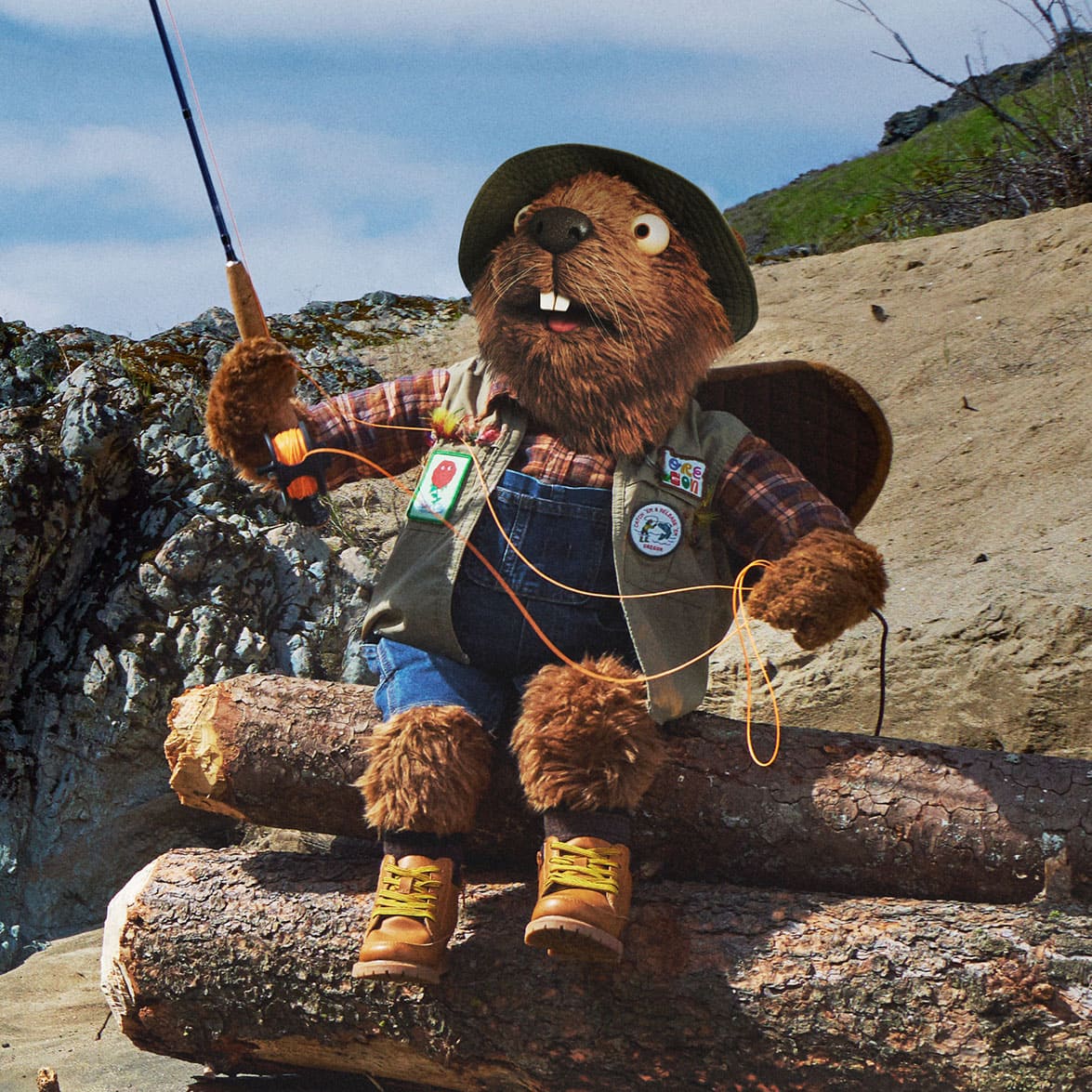A new generation of Oregon anglers proves that learning how to fish doesn’t need an age requirement — or season.
Oregon winters are often marked by cold winds and driving rain; even sleet or snow can be the main entrees on the state’s winter weather menu. Still, there’s a certain breed of Oregonian who say, “There’s no better time to be outdoors!”
One of those Oregonians, Team Hook-up Guide Service owner Jack Glass, says the Sandy River, although 30 minutes from downtown Portland, feels like it’s a million miles away from city hubbub. Glass is an accomplished pro fishing guide — with more than four decades of experience on Oregon rivers — but says he never tires of taking youngsters fishing for steelhead trout.
Joining him on this winter fishing getaway are teenagers Kennedy Shuler, Grant Embre and Tess Raz. Although young, the crew’s enthusiasm is easy to spot. All eyes are on Glass as he instructs the crew on how to cast.
“You want to slowly bring the rod back behind you,” says the longtime fishing guide. “Then, pause for a moment, and cast. You don’t need to cast far — maybe 20 yards toward the bank. Let it hit the water and close the spinning reel’s bail.”
On this gray-shrouded February morning, marked by intermittent showers and a temperature hovering near 40 degrees, Glass shepherded the boatload of eager youngsters and their parents up and down the Sandy River.
Glass especially loves to watch kids catch their very first steelhead. His strategy: encourage them at every turn with gear they can handle, a simple bobber and bait and a technique called “Bobber Doggin.”
“It’s a pretty forgiving way to fish,” says Glass. “Throw the bobber out there and when it disappears you swing — jerk as hard as you can. So, it’s a pretty easy deal for the young ones to handle.”
Glass is a big believer that if you give a kid a rod and reel, show them how it works, and you’ll get them hooked after the very first bite.
Twelve-year-old Grant Embre doesn’t have to wait long — his bobber sinks right after his first cast.
“Fish on, fish on! Grant has a fish on,” yells our guide. A streaking silver flash erupts from the river as a 10-pound steelhead puts on quite an acrobatic show. Soon, the gleaming steelhead is in the net.
“See what I mean!” says Glass. “Kids listen, they really listen — you tell them to do something and they do it. It’s terrific fun to take kids out on the river because they absorb the information and follow instructions.”
“It’s not just fun for us kids,” says a beaming Embre. “It’s also fun for the parents. Even if you don’t catch fish, it’s fun to be on the river because you might see wildlife like bald eagles. You also get a break from the TV and video games.”
We are soon underway again and round a bend in the river.
Then, Glass slows the boat: “Ah, this spot here is what we call ‘Powerline Drift,’” notes Glass. “A real sweet steelhead spot — kind of shallow with a little bit of an island, but an all-gravel bottom — a perfect spot to intercept a steelhead.”
Steelhead are ocean-going rainbow trout that can reach 20 pounds or more. Anglers prize them for strength, stamina and endurance. There’s simply no finer fish on hook and line. Many devotees call them the “street fighters” of the anadromous fish world because they often travel the furthest and endure the harshest environmental conditions in order to reach their spawning areas that are located high in the watershed.
“We use a spinning rod and reel, cast close to shore and then drift along the bank in the boat,” says Glass. “We really use the boat to present our baits. The more water you cover, the more chances you have of presenting it to more fish, so this method of moving downstream presents your gear to more and more fish. That adds up to more catching!”
“There you go, jerk, jerk, jerk!” shouts Glass. “Kennedy has one — go girl go!”
The fish rushes up and down the stretch of river that Glass has chosen for us. Kennedy holds the rod tip high as the reel’s drag applies just the right amount of pressure and the 15-pound test line holds tight.
She soon has the fish under control and near the boat. Glass slips the net under the fish and brings it aboard. He tell us it is a dandy eight-pound hatchery steelhead.
How could Glass tell the fish was born in a hatchery?
“All of the hatchery fish have their adipose fins [a smallish, half-moon shaped fin located between the dorsal fin and the tail] clipped before they’re released from the hatchery as babies,” explains Glass. “Look back by the tail and you can see this fish doesn’t have one—so it’s a hatchery male steelhead, and it’s absolutely gorgeous.”
I ask Kennedy to describe how it felt hooking and playing a steelhead.
“It’s a good feeling,” she says. “It’s like a challenge to get it in the boat. I really like that challenge because it isn’t like anything else.”
As we continue our fishing trip, Jack tells me the Sandy River offers good bank access for anglers, too. That’s especially true at parklands like Dabney State Recreation Area and Oxbow Regional Park — and even further upriver. Glass insists that boaters should practice good sportsmanship and allow bank fishermen plenty of elbowroom. The Sandy River is born high in the glaciers of Mt. Hood, and it keeps boaters on their toes because river safety is critical.
“Quite often there are trees that come down because of wind storms or freezing weather conditions,” explains Glass. “They can even block entire channels, so you’ve got to be aware all of the time whether you drift or jet boat the river.”
He adds that folks who choose to ride with him play it safe by wearing inflatable life jackets throughout their trip. The life jackets are so lightweight, you hardly realize you’re even wearing one.
Within moments of Glass’s comments, 11-year-old Tess Raz’s bobber disappears under the surface and her fishing rod doubles over and throbs with the pulsing fight of an eight-pound, nickel-plated steelhead.
“Ohhhh, nice fish…man oh man it’s gorgeous,” Jack yells as monofilament screams off her reel. “She’s got a real barn-burner on her hands.”
Jack smiles, I laugh, and Tess seems a bit nervous. She does not want to lose this fish. Tess ties into a dandy and handles the rod like a pro.
Her dad, Art Raz, says he scheduled outdoor time with his daughter from an early age. As soon as she could walk she joined him for fishing adventures.
His advice to other parents: “Make the time and spend the time with them! You have to because they grow up way too fast. Every time I hooked a fish, I handed her the rod, and now—as you can see—she’s catching more fish than me.”
Tess soon has the fish next to the boat and Glass scoops it aboard. It’s a fine hatchery steelhead. I ask her what she enjoys the most about steelhead fishing.
She replies, “Well, you can have really good family experiences and sometimes — like today — you’ll make a lot of fun memories.”
That’s a fine piece of impressive wisdom from a youngster who truly understands the values that come from fishing. It’s not always about the catch, but about the time you spend outdoors learning and experiencing something new.
Glass smiles and adds, “These young folks are the future for our sport — and especially managing our resources. Engaging them in activities like fishing makes a huge difference down the road and for the future of angling in Oregon.”
You can learn more from Jack Glass about hooking kids onto fishing at this year’s Pacific Northwest Sportsmen’s Show at the Expo Center. Glass will be a on hand at the Portland Metro Toyota Dealers Association Booth #607. He is also a featured guest speaker at the show, so he is available to answer your questions on “Getting Kids Hooked on Steelhead.”
